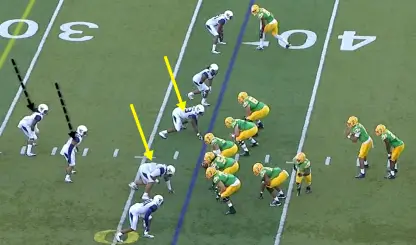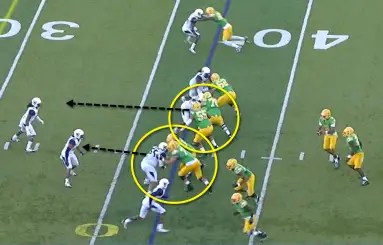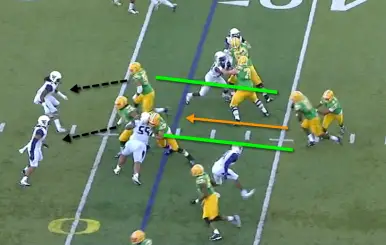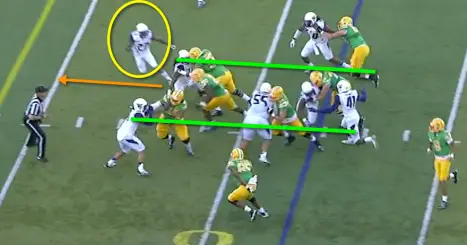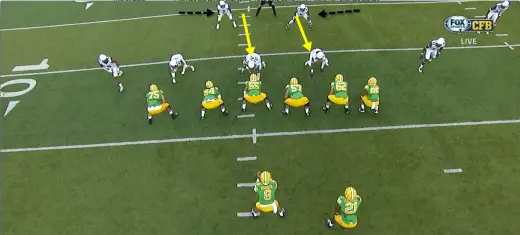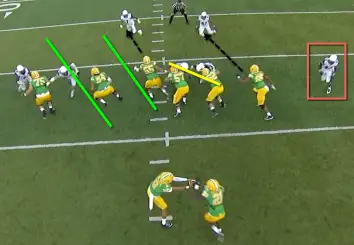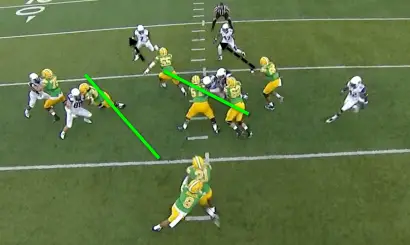I used to have a coach that said the key to winning football games was winning the war in the trenches. Obviously, there are many factors involved in winning football games, but it is hard to argue against the importance of controlling the line of scrimmage.
Early in 2014, Oregon suffered multiple key injuries to the offensive line, resulting in a scenario where the Ducks had barely scraped past Washington State and were upset by Arizona. Again.
And let’s not forget the bye week in between. That was probably fortunate.
Many of the issues during this three week stretch stemmed from pass protection, but there is evidence that offensive production suffered in the run game as well. Oregon averaged 6.34 yards per carry and four rushing touchdowns per game in its first three contests. Against Washington State and Arizona, these numbers dropped to 3.81 YPC and 0 TD’s. Part of this was competition, since Oregon played South Dakota and Wyoming early. Still the reality is winning in the trenches is tough with inexperienced linemen.
A few years ago, I wrote an article on developing offensive linemen for the zone blocking scheme. It provides an overview of the zone blocking system and discusses some of the ways coaches develop offensive lineman to execute the required techniques. Today we are going to focus on the combo block and take a look at how a healthier offensive line won in the trenches against the very talented defensive front of the Washington Huskies.
A Zone Scheme Primer
The basic concept of zone blocking is the same for both inside and outside zone blocking schemes. While there are different wrinkles and rules, the key premise is that blockers have an area assigned to them rather than a man. In a man blocking scheme, the offensive lineman’s assignment is to block a specific defender with a goal of moving him from point A to point B to create a specific running lane. In the zone scheme, the offensive lineman is assigned a gap with a goal of controlling his gap and creating horizontal flow that allows a running lane to develop.
The Combo Block

When executing a combo block in the zone scheme, offensive linemen must read and react to the defense in order to control their gaps. It often becomes a two for two situation where there will be a double team until the linebacker threatens a gap. When this occurs, the lineman responsible for that gap reads the backer and releases to block him.
One of the benefits of the zone blocking scheme is the ability to create combo block opportunities. A combo block works much like a double-team and allows for greater movement at the point of attack, but it is also more flexible and doesn’t waste a blocker. In a traditional double-team, there are two blockers for one defender and they will block him until the whistle blows or he is on his back. There isn’t any accountability for other defenders.
With a combo block in the zone scheme, the double-team only exists momentarily until the offensive lineman involved can read the linebacker and release when his gap is threatened or his teammate has control of the block. This allows the offensive linemen to better handle stunts and blitzes by the defense. As long as the linemen feel the down lineman and see the backer, they should be able to anticipate what the defense does and adjust.
This flexbility was critical to Oregon’s success against Washington. If you are following the draft or read anything about the 2014 Washington Huskies, you are probably aware that they had a very good defensive front. It is possible that three players from their front seven will be drafted in the first two or three rounds, and their NT Danny Shelton, will likely go in the first round.
Winning in the Trenches against Washington
With Washington’s front seven, the flexibility of the combo block proved to be critical as Royce Freeman rushed for 169 yards and four touchdowns. Let’s take a look at how the Ducks’ offensive line created running room using combo blocks in the zone scheme.
Example 1
In the screen shot above, we see Washington lined up in a six-man front. In this example we will see two combo blocks on the interior defensive linemen (yellow arrows), while the offensive linemen keep their eyes on the linebackers (black arrows).
As the play develops (above), we get two distinct double-teams on the first level to create movement and dictate linebacker flow. All four offensive linemen have their eyes on the backers and are making a read to determine who will release. In the top combo block, we see the defensive lineman working to the guard’s outside shoulder. This is an early indication that the center will release to block the linebacker.
As the play continues to develop (above) we see two linemen release to linebackers while the other two remain and attempt to seal off the defensive linemen. In the top combo block, as the early read indicated, the center releases to the linebacker and the guard stays on the DT. In the bottom combo block on Danny Shelton, the offensive tackle of Oregon takes over the block and the Duck guard releases to the linebacker.
The screen shot above shows Royce Freeman slipping past the first level defenders just as the releasing offensive linemen are engaging the linebackers. The running lane is clear and Freeman takes advantage.
As Freeman heads toward daylight in the secondary, note the safety running downhill to provide run support (circled above in yellow).
Above we see the center (Hroniss Grasu) pancaking the linebacker and disrupting the safety’s pursuit of the ball carrier. This allows Freeman to break free and score.

Great blocking can lead to this!
Example 2
In this example, we see (above) a seven-man (3-4) front and have the potential for two combo blocks. The first will be on the defender covering the center while the second will be on the lineman on the inside shoulder of the tackle (yellow arrows). Once again, they will be comboing to the interior linebackers (black arrows).
As the play develops, we see (above) the center and the guard engaging in a combo block on Shelton, while keeping their eyes on the left ILB. The other combo block doesn’t happen because the defender shoots hard to the A-Gap, leaving the tight end free to release immediately to the backer.
Here we see the right guard and tackle working to seal off the first level defenders as the center and tight end release to the second level. We begin to see the running lane develop.
The running lane becomes more defined (above) as the releasing blockers climb to the second level.
As Freeman pushes through the hole we see the center engage the linebacker, however, the tight end was slow on his release and isn’t able to cut off the defender. Even so, Freeman was still able to gain significant yardage.

Zone blocking gets the Oregon offense out of a hole.
Final Thoughts
As a former offensive lineman who played in both a zone scheme and a man scheme, and a coach who has coached both systems, I can attest to the zone scheme’s effectiveness in giving the offensive line another advantage. The above examples provide some insight into how the combo blocking technique within the zone scheme can be effective against very good defensive players.
It can, if executed properly, allow the offense to win enough battles in the trenches to ultimately win the war…and as my coach used to say, that is the key to winning football games.
I may be in New York, but “Oh how we love to learn about your beloved Ducks!”
Coach Levi Steier
Oregon Football Analyst for CFF Network/FishDuck.com
Albany, New York
Featured photo by Gary Breedlove
OptionFootball.net (by Coach Levi Steier) provides coaches and fans with resources, information, and a place to discuss option football and other football related topics. We are looking to develop a strong community of coaches and fans that can learn from each other and promote a better understanding of the game and all of its intricacies.
Related Articles:
Levi Steier, (Football Analyst) after a collegiate playing career cut short by injuries, began his coaching career as a student assistant at Dakota State University. Since then he has coached primarily at the high school level. During this time he has been a head coach and has coordinated all three phases of the game. He is currently the owner of a web design business and the publisher at OptionFootball.net where he discusses many aspects of football, but regularly focuses on option oriented football topics. Coach Steier enjoys talking football and encourages anyone who would like to discuss the game or find more information to visit his site. You can follow Levi on twitter @OptionFootball, on his Facebook page and on Google+.


